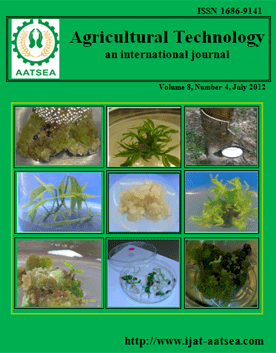ThaiScience
ThaiScience
INTERNATIONAL JOURNAL OF AGRICULTURAL TECHNOLOGY
Volume 16, No. 02, Month MARCH, Year 2020, Pages 223 - 236
Antimicrobial characteristics of wool fibers treated with chitosan-propolis nano composite and dyed with natural dye extracted from red prickly pear
Ali, N. F. and Abd- El salam, I. S.
Abstract Download PDF
Nanotechnology provides a new concept for the improvement of the antimicrobial activity of the textile fibers. Natural dye extracted from red prickly pear using microwave heating was used for dyeing wool fibers. Chitosan-Propolis nano composite was applied as treatment on wool fibers before dyeing by using microwave and ultra sonication methods. The dye concentration and pH factors as well as color strength, color data and fastness properties of the dyed wool fibers were investigated. The results indicated that wool fibers pretreated with the tested nanomaterials exhibited better results than the untreated samples. Nano composite of chitosan and propolis showed antimicrobial activity against some pathogenic fungi and bacteria. The results indicated that the antimicrobial activity of the natural dye under investigation was good and it was enhanced by treatment with the nano composite. The morphological structure of the untreated and pretreated wool fibers was examined by scanning electron microscopy (SEM). The untreated wool fibers have a rough surface. The pretreated wool fibers were swollen as compared to the untreated fibers. The diameter of the fibers increased, and the surfaces became smooth and even.
Keywords
Nano chitosan, Propolis, Red prickly pear, Natural dye, Antimicrobial activityINTERNATIONAL JOURNAL OF AGRICULTURAL TECHNOLOGY
Published by : Association of Agricultural Technology in Southeast Asia (AATSEA)
Contributions welcome at : http://www.ijat-aatsea.com
